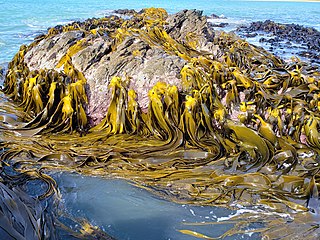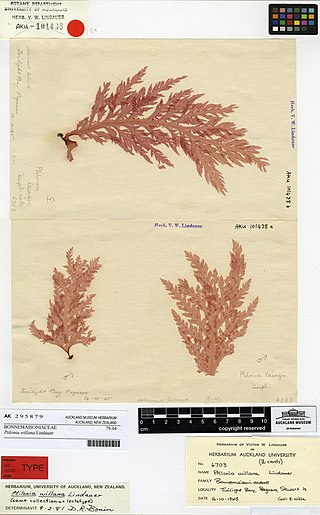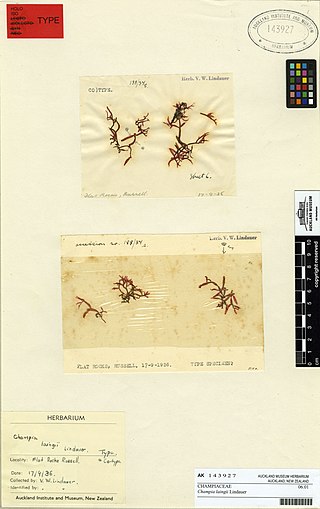
Durvillaea is a genus of large brown algae in the monotypic family Durvillaeaceae. All members of the genus are found in the southern hemisphere, including Australia, New Zealand, South America, and various subantarctic islands. Durvillaea, commonly known as southern bull kelps, occur on rocky, wave-exposed shorelines and provide a habitat for numerous intertidal organisms. Many species exhibit a honeycomb-like structure in their fronds that provides buoyancy, which allows individuals detached from substrates to raft alive at sea, permitting dispersal for hundreds of days over thousands of kilometres. Durvillaea species have been used for clothing, tools and as a food source by many indigenous cultures throughout the South Pacific, and they continue to play a prominent role in Chilean cuisine.

Durvillaea willana is a large species of southern bull kelp endemic to New Zealand.

Chlorokybus is a multicellular (sarcinoid) genus of basal green algae or charophyte. It has been classified as the sole member of the family Chlorokybaceae, which is the sole member of the order Chlorokybales, in turn the sole member of the class Chlorokybophyceae. It grows on soil and rock surfaces, and is rare.

Asparagopsis armata is a species of marine red algae, in the family Bonnemaisoniaceae. English name(s) include red harpoon weed. They are multicellular eukaryotic organisms. This species was first described in 1855 by Harvey, an Irish botanist who found the algae on the Western Australian coast. A. armata usually develops on infralittoral rocky bottoms around the seawater surface to around 40m of depth. Marine algae like A. armata are considered "autogenic ecosystem engineers" as they are at the very bottom of the food chain and control resource availability to other organisms in the ecosystem.

The Rivulariaceae are a family of cyanobacteria within the Nostocales in which the filaments (trichomes) are tapered from wider at the base to narrower at the tip.

Polysiphonia morrowii is a species of red algae native to Northeast Asia. It has become an invasive species in Europe, Australia, New Zealand, and South America.

Caulerpa subserrata is a species of seaweed in the Caulerpaceae family.

Ptilonia(Harvey) J. Agardh, 1863 is a genus of red algae in the family Bonnemaisoniaceae.

Eileen Alice Willa (1905–1999) was a New Zealand botanical collector, museum curator and writer.

Spatoglossum chapmanii is a marine brown algal species in the family Dictyotaceae, endemic to New Zealand.

Champia laingii is a marine red algal species endemic to New Zealand.

Champia is a genus of red algae in the family Champiaceae, first described in 1809 by Nicaise Auguste Desvaux
Victor Wilhelm Lindauer (1888–1964) was a New Zealand phycologist, collector and teacher.

Sporochnus elsieae is a marine brown algal species in the family Sporochnaceae, endemic to New Zealand. It was first described in 1960 by Victor Lindauer who gave it the specific epithet, elsieae, in honour of his wife, Elsie.











